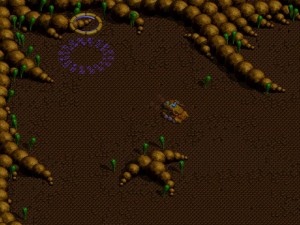Gromada
 As with every post these days, I’m posting this a few days late. It was when I was playing the Lexaloffle retro-styled games that I started thinking about playing something from the stack that came by that style more sincerely. I’m not sure why Gromada is the one that stuck in my head. Heck, I’m not sure why I even own it. Probably because it was cheap and in an eye-catching, colorful package. At least it still installs and runs without problems.
As with every post these days, I’m posting this a few days late. It was when I was playing the Lexaloffle retro-styled games that I started thinking about playing something from the stack that came by that style more sincerely. I’m not sure why Gromada is the one that stuck in my head. Heck, I’m not sure why I even own it. Probably because it was cheap and in an eye-catching, colorful package. At least it still installs and runs without problems.
Gromada is an isometric sci-fi tank game from Russia. It seems to go out of its way to emphasize its nation of origin, in fact, as if to appeal to all those Red Alert fans who instinctively associate Russia with massive supertanks. (And yes, it was released at about the right time for this to be a plausible factor.) I’m not sure this is the case, though. The two chief things that suggest conscious russification are the way that the opening animation displays the logo as “Громада” at first, and the way that the mission briefings are often awkwardly translated, with not enough articles. But the former could just be a matter of Bethesda (who published the game in America) not wanting to spend the money to redo the animation from the beginning, and the latter could just be plain ordinary cheap-videogame bad translation.
Everything, including vegetation, is rendered with a plasticky Gouraud-shaded sheen, as if it’s all toys — and the canary yellow paint favored by the enemy emphasizes this more. I’ll say this: the vehicles rotate remarkably smoothly for a sprite-based game. Presumably a lot of time and effort was devoted to this, an effect that we get trivially in the age of 3D.
Your supertank can be controlled from either mouse or keyboard. The keyboard controls are avatar-relative — “tank controls”, as they’re sometimes called. This is at least appropriate to the context, but I much prefer the mouse, which is a simple click-to-go-here system, complemented by click-to-fire-here on the other mouse button. (This is the sort of tank game that lets you rotate your turret independently of your direction of movement.) This still has its problems, mind. You can hold down the fire button to keep on continuously firing at a single point (as long as your ammo holds out, anyway), but, inconsistently, you can’t hold down the go button to continuously update where you’re moving. Also, tanks need to move in a circle in order to turn, and the mouse doesn’t give you direct control over which direction you’re circling in; for small turns, it’ll choose the most direct way, but if you suddenly have to go back the way you just came, you can wind up bumping into perfectly avoidable walls. Still, the click-to-move system lets you essentially set your tank on autopilot so that it doesn’t stay still while you concentrate on shooting at things, and that’s pretty nice.
It strikes me that it’s been a while since I played a game with printed documentation. The manual for this game, while pamphlet-sized, is surprisingly thick, given the game’s fundamental simplicity, but it turns out to be mostly occupied with an illustrated backstory. The portion devoted to the game basically just summarizes the menus and the controls, not even giving the rundown of enemies and pickups that, say, its fellow tank game Combat (2001) does. Note that Combat was released a mere two years after Gromada, and furthermore is deliberately retro, even to the point of containing limited lives, but it seems ages closer to modern design sensibilities all the same.
 Comments(0)
Comments(0)